
Zeno is a lunar impact crater located near the northwestern limb of the Moon. It was named by the IAU in 1935.

Alter is a lunar impact crater that is located in the northern hemisphere on the far side of the Moon. It lies to the southwest of the larger crater Robertson, and to the east of Ohm.

Arrhenius is a lunar impact crater that is located just on the far side of the Moon, near the southwest limb. In this location the vicinity of the crater can be viewed during favorable librations, although it is viewed from on edge. To the south-southeast is the worn crater Blanchard, and De Roy lies further to the west.

Artamonov is a lunar impact crater on the far side of the Moon. Its eroded outer rim does not have the circular shape of most lunar craters, but the overall shape of three or four merged craters. The largest is in the south, with smaller circular bulges to the north and east.
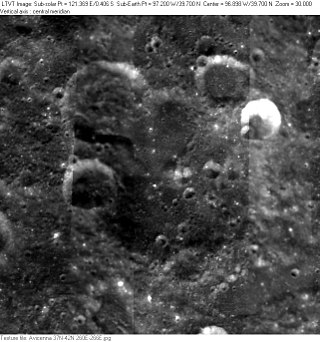
Avicenna is a lunar impact crater that lies on the far side of the Moon, just beyond the western limb on the northern rim of the Lorentz basin. It is named after the Persian polymath Avicenna. It lies to the north-northwest of the larger crater Nernst, and to the southeast of Bragg.

Boss is a lunar impact crater that is located along the northeast rim of the Moon's near side. Due to its location, the crater is viewed from the side by observers on the Earth, and its visibility is subject to libration effects. It was named by the IAU in 1964 for astronomer Lewis Boss.
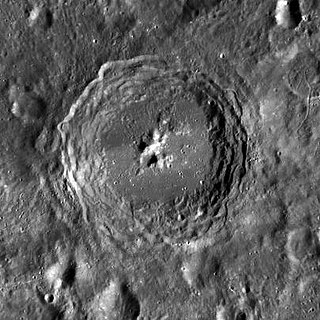
Robertson is an important lunar impact crater that is located on the far side of the Moon, just beyond the western limb. It lies just to the south of Berkner, a formation with a comparable size but more eroded features. Just to the east is Helberg, and to the southwest is Alter.

Bragg is an ancient lunar impact crater that is located on the far side of the Moon, just beyond the northwest limb. This formation has been heavily eroded and reshaped by subsequent impacts, leaving an irregular depression in the surface. The most intact portion of the rim is along the western face, while the northern and eastern rim has been nearly worn away and is overlaid by several smaller craters. The most notable of these is Bragg H, which lies across the east-southeastern rim.

Bunsen is a lunar impact crater that lies near the northwestern limb of the Moon. It is located to the west of the Oceanus Procellarum and the crater von Braun. To the southeast is the crater Lavoisier, and to the northeast lies Gerard. Northwest of Bunsen, on the far side of the Moon, is McLaughlin. Due to its position this crater appears foreshortened when viewed from the Earth, and its visibility is affected by libration.

Cusanus is a lunar impact crater that is located near the northeastern limb of the Moon. In this location the crater appears very foreshortened when observed from the Earth, and its visibility is affected by libration. The northern rim of Cusanus is nearly joined to the south-southeastern rim of the larger crater Petermann. To the west is Baillaud and to the southeast is Hayn.

Damoiseau is a lunar impact crater that is located just to the west of the Oceanus Procellarum, in the western part of the Moon's near side. It lies due east of the prominent crater Grimaldi, a walled plain with a distinctive dark floor. Due south of Damoiseau is the crater Sirsalis.

Chapman is a lunar impact crater that lies just beyond the northwest rim of the Moon, on the far side as seen from the Earth. It lies to the northeast of the crater Rynin, and southward of the large walled plain Poczobutt.

Chevallier is a lunar impact crater that is located in the northeastern part of the Moon's near side, about a crater diameter east-southeast of the prominent crater Atlas. To the south-southeast of Chevallier is the flooded crater Shuckburgh. Chevallier was named by the IAU in 1935.

Danjon is a lunar impact crater on the far side of the Moon. It lies less than a crater diameter to the east-southeast of the larger crater Langemak. To the east-northeast of Danjon is the crater Perepelkin, and due south lies the walled plain Fermi.

Dellinger is a lunar impact crater that is located on the Moon's far side. It is attached to the southern rim of the crater Pannekoek. To the southeast lies the crater Marconi, and to the southwest is Chauvenet.
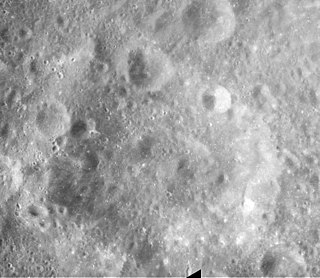
Gregory is a lunar impact crater on the far side of the Moon. It is located to the southeast of the crater Ibn Firnas, and north-northeast of Bečvář. About one crater diameter to the north is the smaller Morozov.

Helberg is a lunar impact crater that is located just behind the western limb of the Moon, on the far side from the Earth. Due to libration this part of the surface is sometimes brought into view, and the crater is visible under suitable lighting conditions. However even under these circumstances the crater is viewed from the edge and not much detail can be seen.
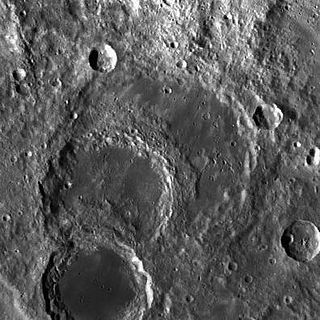
Richardson is a large lunar impact crater located on the Moon's far side, just behind the eastern limb. It lies to the south of the huge walled plain Harkhebi, and to the east-southeast of the crater Vestine. Just to the northeast is Szilard, and to the southeast is Artamonov.
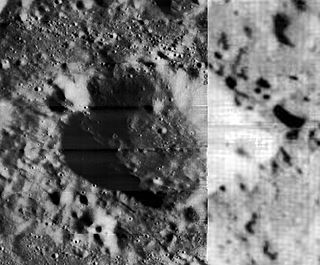
Šafařík is a small lunar impact crater on the far side of the Moon. It lies due north of the crater Tiselius and to the east-southeast of Sharonov. This is a worn and eroded crater with smaller impacts along the rim to the east and northwest. The remainder of the worn rim and the interior are relatively featureless.

Parenago is an impact crater on the Moon's far side, behind the eastern limb. Nearly attached to the east-southeastern outer rim of Parengo is the crater Berkner. To the south-southwest lies Comrie.






















